"Maxims" for Switzerland. MG11 machine gun
The first machine guns for Switzerland were in one way or another refined design, previously created by Kh.S. Maxim. For its time, this weapon was the highest achievement of science and technology, but later the situation began to change. At the beginning of the 20th century, the designers of several countries proposed a number of their own projects of weapons of a similar class, which contributed to further progress, but could hit the potential of the armaments in service. Not wanting to risk, at the end of the zero years of the 20th century, Switzerland was forced to begin the search for a new machine gun, with the help of which it was necessary to re-equip the army.
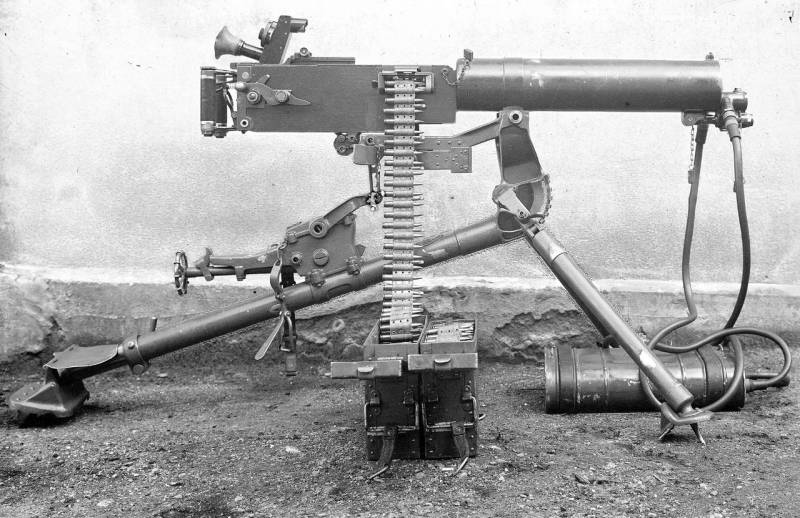
MG11 machine gun on the machine. The casing is connected to a water tank. Photo by Schweizerisches Bundesarchiv / Swiss-archives.ch
In parallel with the creation of completely new machine guns in different countries, the further development of the Kh.S. design continued. Maxim. The patent for this development has ended, which allowed gunsmiths of leading countries to begin upgrading the existing sample, aimed at improving the basic characteristics. One of the developers of a promising project based on the existing system was the Berlin-based Deutsche Waffen und Munitionsfabriken, AG (DWM). By the end of the decade, she had developed a new version of the machine gun, which by the year of its creation was designated Model 1909.
The main problem of early machine guns developed by Kh.S. Maxim were relatively large size and weight. At the beginning of the 20th century, in connection with the advent of more advanced designs, the need to correct such shortcomings became apparent: otherwise, the time-tested and popular weapon could lose in competition with newer models. For this reason, one of the main tasks of the Model 1909 project was to reduce the weight of the machine gun. By refining various components and assemblies, DWM designers managed to reduce the mass of the product by about a third, without losing other characteristics.
The new DWM Model 1909 machine gun was offered to various potential customers, including the Swiss Army. Having armed with other machine guns, based on the product "Maxim", the Swiss armed forces showed some interest in the new foreign development. Most of all they were attracted by the reduced weight of the weapon, which made it possible to simplify the operation and combat use. The result of the interest shown was a contract for the revision of the existing sample according to Swiss requirements and the subsequent launch of mass production. In accordance with this document, the new machine gun had to use rifle cartridge 7,5 x55 mm GP11, created in Switzerland shortly before. The rest of the machine gun could retain existing design features.
The finalization of the project, the testing of finished machine guns and the subsequent bureaucratic procedures took some time. Only in 1911, the updated Model 1909 machine gun from DWM passed state tests in Switzerland, the results of which were recommended for adoption. Soon came the corresponding order, and in addition, an agreement was signed on the serial production of weapons. The modified Model 1909 machine gun was to be operated by the Swiss army under the name MG11.
One of the main goals of the Model 1909 / MG11 project was to reduce the weight of the structure as much as possible. In the course of development, it was found that such plans can be successfully completed by refining these or other weapon parts. At the same time, it was possible to do without changes in the principles of work and the overall architecture of the product. As a consequence, the German machine gun arr. 1909 was superficially similar to its predecessor, although it had some differences that affected the mass of parts.
The MG11 machine gun retained the overall layout of the base sample. The main parts of the weapon were placed inside a rectangular receiver, closed by the top cover. In front of the box was attached a large cylindrical housing, inside of which was a movable barrel. Like other machine guns, based on the design of "Maxim", MG11 had to use water-cooled barrel, which forced the authors of the project to keep the casing-capacity. In the front part of the casing, nozzles appeared to attach the hoses, with the help of which it was proposed to supply water for cooling. On the outer surface of the weapon, especially on the rear wall of the receiver, there were devices for controlling the operation of mechanisms.
The principle of the weapon remained the same. The machine gun used automation based on recoil of the barrel with a short stroke. Performing reciprocating movements under the influence of recoil, the barrel actuated other mechanisms placed inside the receiver. The design provided the bolt with lever locking system. During firing, two levers connected to the bolt and between themselves had to move along predetermined trajectories, ensuring locking the barrel bore with subsequent unlocking by recharging. The lever system was connected with a manual reloading handle, bred to the right side of the receiver.
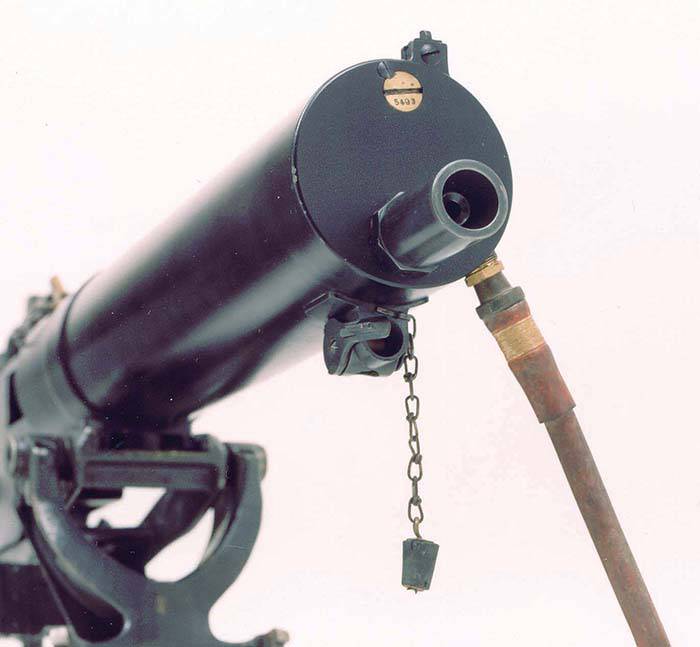
The muzzle of the barrel and the casing with attached hose. Photo by Smallarmsreview.com
The shutter was a part of complex shape with a large plate front part, which had a T-shaped groove for interaction with the cartridges. At different stages of the recharge cycle, the shutter, moving back and forth, had to remove the new cartridge from the tape, lower it to the barrel line and feed, and then remove the spent cartridge case and lead it to the sleeve tube below the barrel.
The shutter and other mechanisms were controlled by a trigger mechanism, allowing firing only in bursts. The shooting was controlled by the “traditional” release button on the rear wall of the receiver. Next to it were two vertical handles.
In the original version, the MG11 machine gun was equipped with an ammunition system using cloth tapes for ammunition. Feed curb tape was carried out through a window in the right wall of the receiver, the output is empty - through the left window. Standard ribbons, similar to those used with previous Swiss machine guns, were proposed to be carried in wooden boxes of appropriate sizes.
The weapon retained the standard mechanical sight, with which it was possible to fire targets at distances from 100 m to 2,6 km. On the front of the barrel casing there was an adjustable front sight, with the help of which it was proposed to make corrections for the side wind. During various upgrades and upgrades MG11 machine guns received new sights. New systems were proposed for firing at ground and air targets.
Initially, the Model 1909 / MG11 machine guns were completed with a German-designed tripod machine. The machine had three telescopic supports with a choice of length (there were six options for the length of each leg). On the back support of the machine provided for the seat of the machine gunner. The legs were connected by a common platform on which was placed the mechanism for horizontal and vertical pickups with fixtures for mounting a machine gun. Mechanical drives were provided for vertical guidance of weapons, which allowed firing at distances up to 1500 m. For transportation, the machine gun machine could be disassembled. When folded, it had a length of less than 1,1 m and weighed no more than 25 kg.
Soon after the adoption of weapons, a new version of the machine was created, which was a special installation for fortifications and fortresses. On the wall of the fortification it was proposed to mount a large and rather complex system with attachments for the body of the machine gun and means of guidance. Search targets and point at them weapons should be using telescopic optical sight. Outside the casemate, there was only a relatively small opening with a machine gun in a movable shutter. The machine gun and the shooter were protected from both small arms or grenades, and from flame throwers.
The MG11 machine gun for the Swiss army had a length (without machine tool) 1,1 m. The mass of weapons without ammunition and tripods - 18,7 kg. Using a GP7,5 mm 55x11 cartridge, the machine gun could fire at a rate of up to 500 rounds per minute. The initial speed of the bullet reached 750 m / s. Thus, in terms of combat qualities, the new weapon was not inferior to the systems of the previous models that were in service with Switzerland, but differed from them in greater mobility achieved by reducing the mass.
The order for the adoption of a new machine gun was signed in 1911 year. Shortly thereafter, the company DWM began production of weapons in accordance with the existing order. The possibility of producing machine guns in their own factories was probably not considered at that time. The limited production capabilities and the availability of orders from the national army led to the fact that the German plant from 1911 to 1915 was able to transfer to the customer only 167 machine guns of the new model. After that, production ceased. Germany entered the war, because of which its arms industry was forced to move to the implementation of domestic orders, sharply reducing exports.
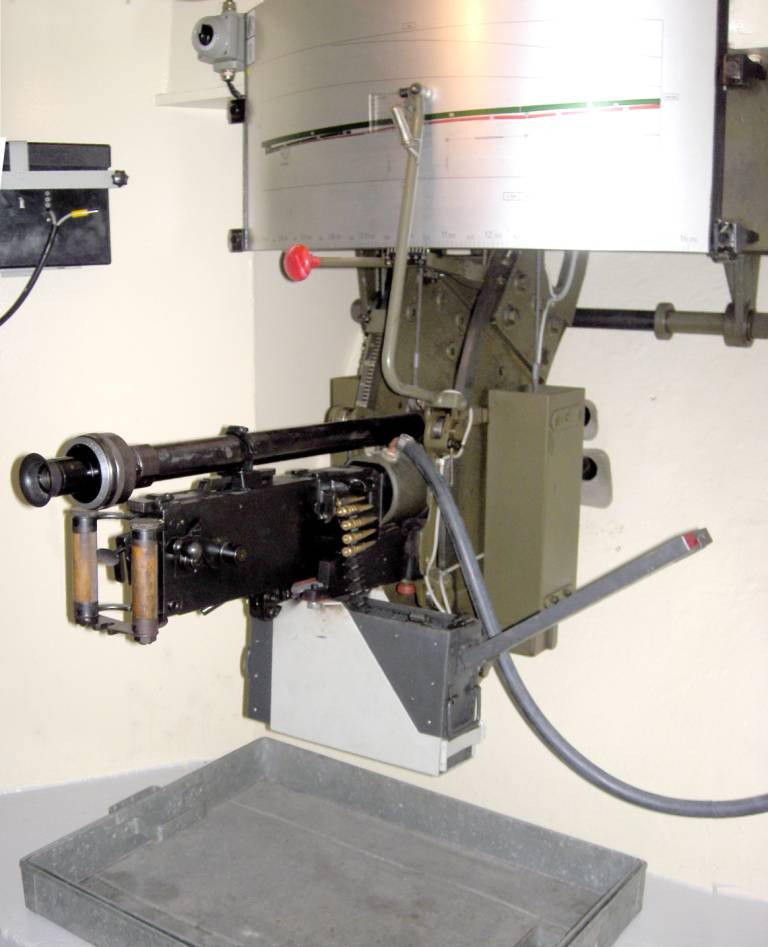
Machine gun installation for fortresses and other structures. Photo of Wikimedia Commons
Supplies of German-made weapons allowed the army to cover only partially the needs. Because of this, the Swiss leadership had to urgently look for a way out. Soon it was decided to entrust the further release of MG11 products to Waffenfabrik Bern (W + F). This plant already had solid experience in the production and maintenance of various systems of small arms, and could well master the assembly of machine guns. Already in 1915, the first machine guns left the W + F conveyor. MG11 production continued until 1946. For three decades, the Swiss industry has transferred to the army 10269 machine guns in different versions and with a different composition of additional equipment.
The mass production of the MG11 machine guns soon made it possible to make them the main weapon of its class. The total number of older products MG94 and MG00 did not exceed a few hundred, which soon helped the weapons mod. 1911 become the most widespread and common sample. During the first few years, three models of machine guns were operated in parallel, although they were intended to solve slightly different tasks. The gradual increase in the share of MG11 led to the fact that this weapon began to crowd out its predecessors.
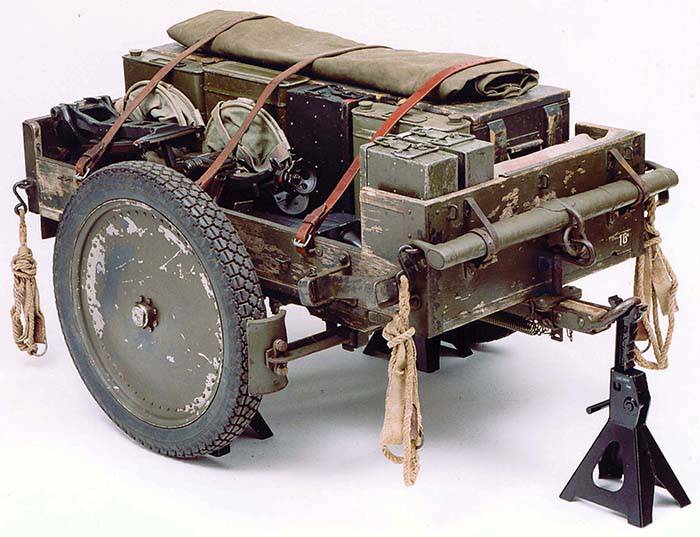
The transport cart, weapon and additional equipment are laid and fixed. Photo by Smallarmsreview.com
In its original form, MG11 machine guns were used until the mid-thirties. For two decades of operation, weapons have become obsolete morally and physically. Its characteristics are not fully satisfied with the military. In addition, new threats have emerged that should also be taken into account in the further development of weapons. Also, new types of weapons appeared: about ten years earlier, the LMG25 machine gun designed by Adolf Furrer was adopted. The massive release of new weapons led to a reduction in the relative share of existing samples. However, the military was not going to write off and dispose of the existing machine guns of old models. On the contrary, it was decided to modernize them with an increase in the basic characteristics and expansion of the range of tasks to be solved.
In 1934-35, W + F implemented the MG11 machine gun upgrade program. At preservation of some basic mechanisms new knots and aggregates were used. In addition, there was an additional equipment of new types, with which the machine gun could solve new problems. The largest processing in the new project has undergone the ammunition supply system. The fabric tape is already hopelessly outdated, which is why it was replaced with non-bulk metal. To do this, we had to noticeably change the design of the tape feed systems. In addition, for storing cartridge tapes, it was proposed to use stamped metal boxes that differed from the existing wooden ones in lower weight.
On the muzzle of the barrel appeared flame arrester new design. Improved shutter release button in the back of the machine gun allows you to fire with just one hand. The second hand of the shooter was proposed to control the mechanisms of the machine, which greatly simplified guidance in various combat situations.
Back during the First World War aviation has become a serious threat requiring appropriate remedies. Swiss industry answered this challenge only in the mid-thirties. A new version of the machine was developed, which, if necessary, could be used when shooting at air targets. It differed from the existing tripod in reduced dimensions and the absence of a gunner’s seat. In addition, the hinges of the support legs were redesigned, which made it possible to raise the machine gun at large elevation angles. It is interesting that such a machine was immediately developed taking into account the use with MG11 and LMG25 machine guns. For greater convenience of anti-aircraft fire, the machine gunner could use an additional metal butt fixed on the weapon.
On the cover of the receiver appeared mounting to install anti-aircraft sight with the so-called. perspective rings. For greater convenience of pointing to a high-speed air target, a white longitudinal strip was painted on the upper surface of the barrel casing. Several types of optical sights could also be mounted on existing mounts. They offered a relatively compact device for use in the infantry, as well as large telescopic sights, which should be used with machine guns on various fortifications.
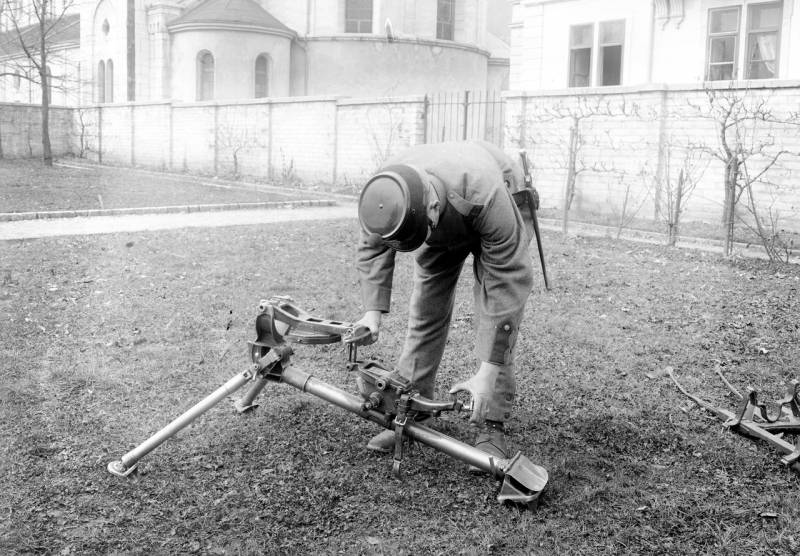
The machine gunner prepares to use the machine. Photo by Schweizerisches Bundesarchiv / Swiss-archives.ch
After the development project of the modernization of the plant W + F began to produce machine guns only in the updated configuration. The basic version products available to the troops over time, too, were upgraded by replacing old units with new ones. This approach allowed for several years to re-equip the army with weapons of an improved model that more fully meets the requirements of the times.
The MG11 machine gun differed from its predecessors in its reduced mass, but lost in this respect to newer developments. Large weight of weapons, ammunition, machine tools, etc. negative impact on the mobility of machine gunners. In the early forties, Waffenfabrik Bern took steps to correct this deficiency. A further reduction in the mass of weapons was not possible, because of which an alternative solution was proposed in the form of a special transport cart.
For transportation from place to place, a machine gun, a machine tool and all the necessary equipment items, including a canister of water and cooling hoses, some spare parts, a tailing tool, etc. it was proposed to lay in a rectangular body of a two-wheeled cart. The cart had a length of about 1,3 m and a width of about 0,7 m. Wheels with a diameter of 660 mm were used. The cart could be towed by any suitable vehicle. In the absence of such, the fighters could independently drag her to the firing position, which required the efforts of four people.
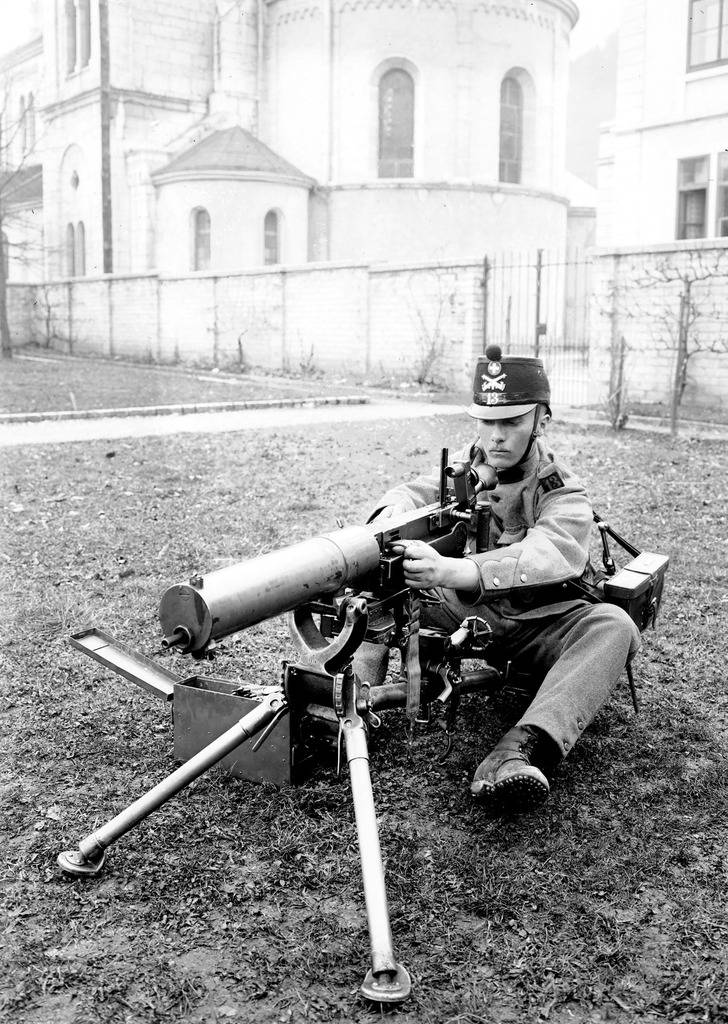
The last stages of preparation for shooting. Photo by Schweizerisches Bundesarchiv / Swiss-archives.ch
While maintaining neutrality in both world wars, Switzerland did not have the opportunity to try out MG11 machine guns during actual hostilities. However, this weapon was used in the most active way during numerous exercises throughout its life. Until the mid-forties, the army received almost 10,5 thousand machine guns, which were distributed among a large number of units and were actively used by them. In this case, over time, MG11 ceased to be the most massive Swiss machine gun. At a certain point, the LMG25 light machine gun became the leader in terms of numbers. In the future, both samples were operated in parallel.
In the late forties, it became clear that the Kh.S. Maxim, despite all the changes and improvements, is hopelessly outdated. Army needed a new weapon. The same conclusions were made on a slightly newer machine gun A. Furrer. Industry has received a new specification. In accordance with it, the MG51 machine gun was soon created, designed to replace all outdated samples. New weapons were put into service in the 1951 year, and soon the army began to receive serial products. However, the replacement of old weapons with a new one was seriously delayed. Due to the limited capabilities of the factory, the W + F machine guns LMG25 could only be decommissioned in the seventies, and the last MG11 were written off only in the early eighties.
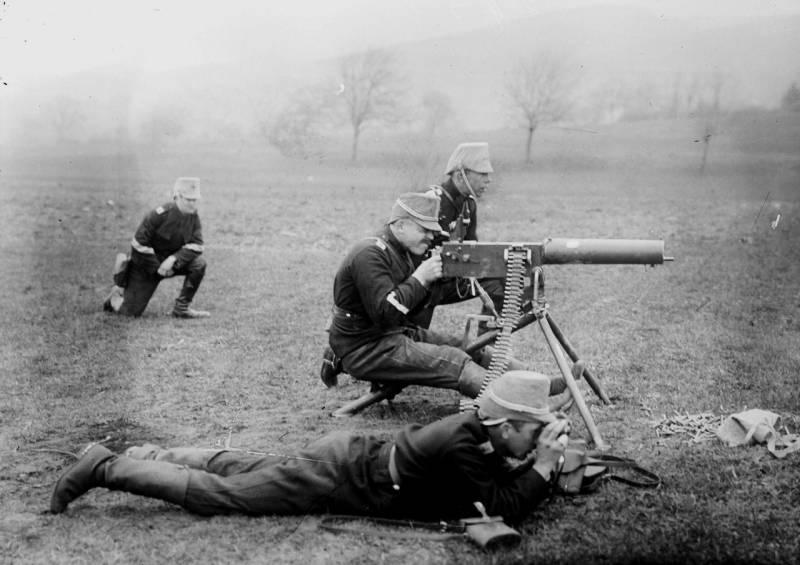
MG11 machine gun and its calculation on drills (1914-18's) Photo Schweizerisches Bundesarchiv / Swiss-archives.ch
Due to moral and physical obsolescence, as well as due to the development of the resource, almost all MG11 machine guns were written off for recycling after being decommissioned. Nevertheless, the large dimensions of the series contributed to a certain extent to the preservation of a certain number of weapons of interest from the point of view stories. Several samples of MG11, now being exhibits of museums and private collections, have survived to our time. From time to time isolated instances of machine guns, to the delight of collectors, appear at gun auctions. But the joy of potential buyers can be overshadowed by the high cost of unique designs. For example, on one of the well-known sites, MG11 is currently being sold in an upgraded version, equipped with an anti-aircraft machine, butt and sight. In addition, boxes and ribbons for cartridges, a canister and a cooling system hose, as well as two different types of optical sights are sold along with the machine gun. The cost of such a kit is “total” 25999 US dollars.
According to some reports, a few years ago, the Swiss army decided to sell the transport carts of machine guns remaining in the warehouses. Unfortunately, lovers of unique technology, a significant number of these products are now used almost for their intended purpose - as vehicles for the transport of various goods. However, some carts were lucky to become museum exhibits.
From the end of the 19th century, the Swiss army used machine guns, which were a development of the Kh.S. Maxim. Machine guns of three models were in service for a long time, at certain periods being the main weapon of their class. However, as time went on, the requirements for weapons varied. A few decades after the start of operation, the Swiss Maxims no longer meet current requirements. The modernization of the mid-thirties allowed to extend their operation, but the army still needed to be fully re-equipped. In the early fifties, the available machine guns began to write off and dispose of. MG11 has ceased to be one of the main machine guns of its country. At the same time, he retained the title of the last attempt of the Swiss military and gunsmiths to use the ideas and developments of Kh.S. Maxim.
On the materials of the sites:
http://smallarmsreview.com/
http://sadefensejournal.com/
http://maximgun.de/
http://armeemuseum.ch/
http://world.guns.ru/
http://collectorsfirearms.com/
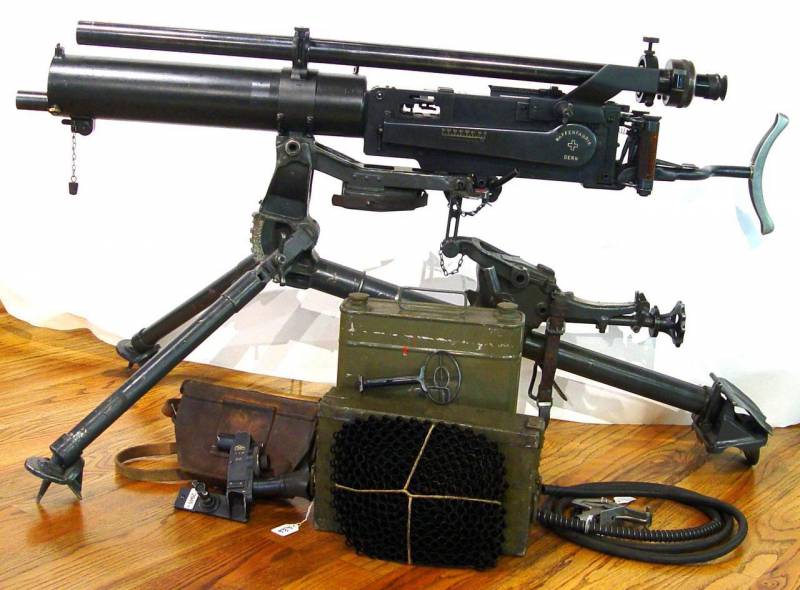
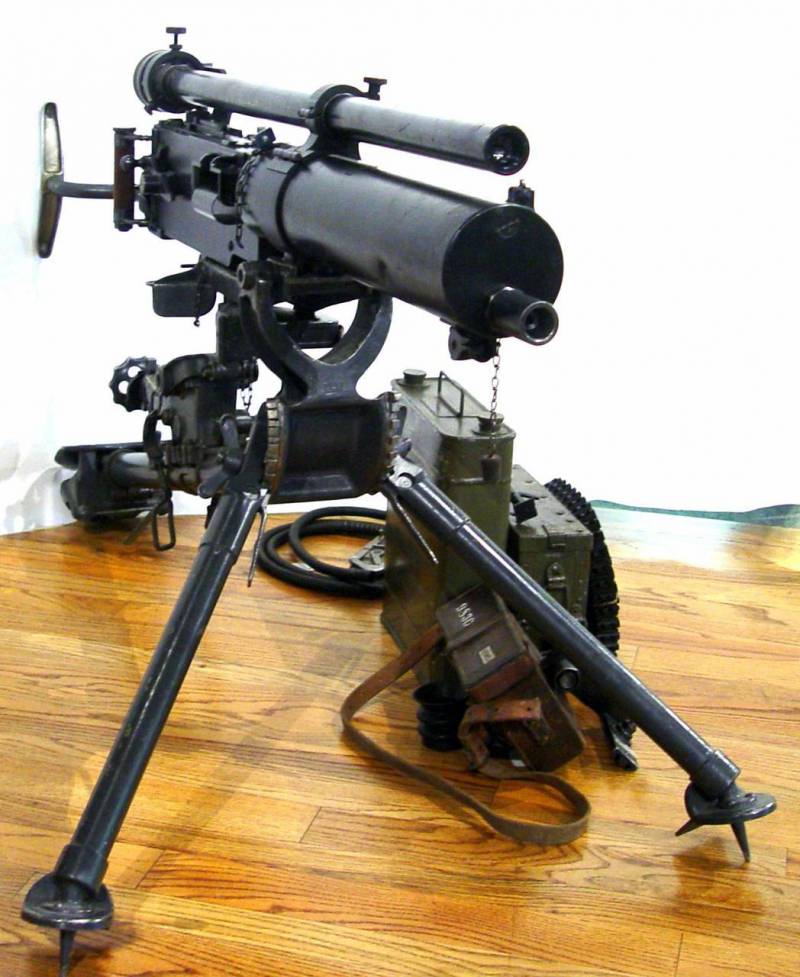
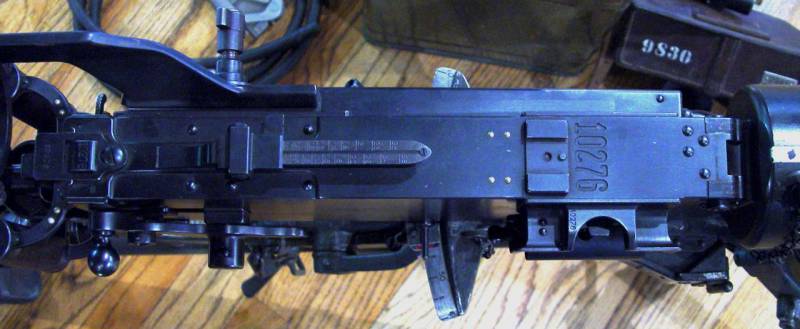
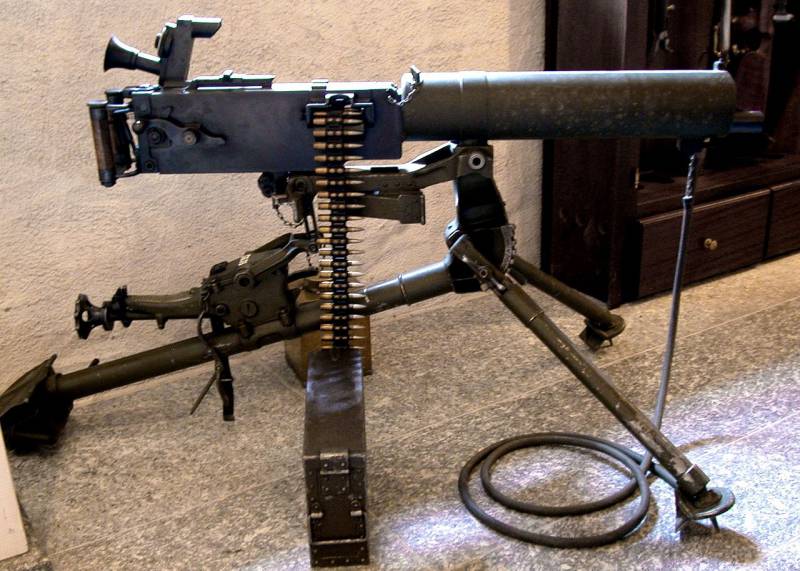
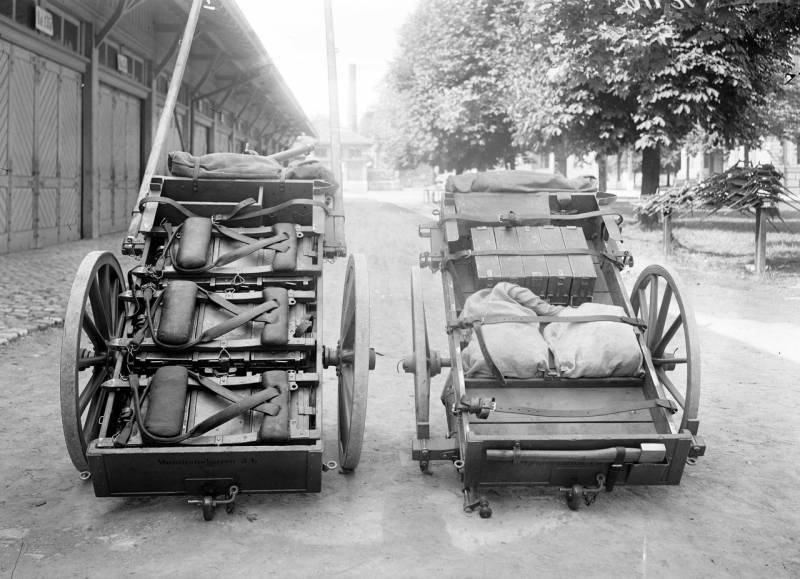
Information